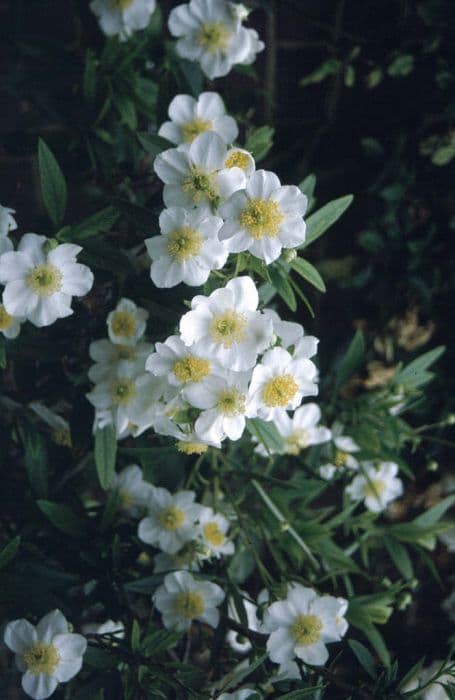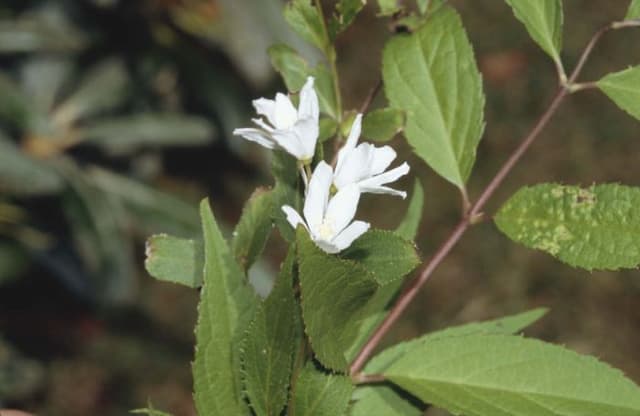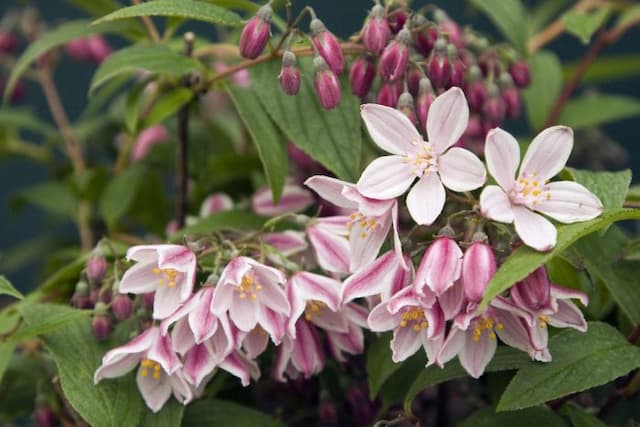Panicle Hydrangea Hydrangea paniculata 'Brussels Lace'

ABOUT
The Hydrangea paniculata 'Brussels Lace' is known for its exceptionally attractive flowers. The plant features conical flower clusters that create a lace-like appearance, hence the name 'Brussels Lace'. These clusters bloom in an array of colors that typically start out as a creamy white and as they mature through the season, they gradually turn to shades of pink and sometimes even a deep red. The blossoms are composed of a mix of sterile and fertile flowers, with the smaller fertile flowers often clustering in the center and the showier, larger sterile flowers around the edges of the cone, giving it a very full and lush look. The leaves of 'Brussels Lace' are a dark green color which provides a bold backdrop for the delicate flowers. The foliage is broadly ovate with serrated edges and they are held on sturdy stems that branch gracefully. As with many hydrangeas, the foliage may also display some color change in the fall, adding another dimension of visual interest to the plant. Overall, the appearance of 'Brussels Lace' is that of a substantial and robust plant, known for its floriferous nature and its ability to provide a dramatic visual impact in the garden. It is a beloved choice for many gardeners looking to create an attractive display with its combination of vibrant blooms and rich foliage.
About this plant
 Names
NamesFamily
Hydrangeaceae
Synonyms
Peegee Hydrangea, Panicle Hydrangea, Panicled Hydrangea
Common names
Hydrangea paniculata 'Brussels Lace'.
 Toxicity
ToxicityTo humans
The common name for Hydrangea paniculata 'Brussels Lace' is panicled hydrangea. Panicled hydrangea is not typically considered highly toxic to humans, but it can cause mild to moderate symptoms if ingested. The plant contains compounds such as hydrangenol, which are found in the leaves and flower buds. If someone eats parts of the plant, they may experience gastrointestinal symptoms such as nausea, vomiting, and diarrhea. In rare cases or with significant ingestion, more serious symptoms could occur, such as dizziness and convulsions. It is generally advised to keep plants out of the reach of small children who might chew on them.
To pets
The common name for Hydrangea paniculata 'Brussels Lace' is panicled hydrangea. Panicled hydrangea is considered to be potentially toxic to pets, including dogs, cats, and horses. The toxic components of the plant, mainly hydrangenol, are found in the leaves, buds, and flowers. If a pet ingests parts of the plant, symptoms of poisoning may include gastrointestinal upset like vomiting and diarrhea. In more severe cases or with large amounts consumed, symptoms may escalate to depression, lethargy, and confusion. Owners should prevent pets from having access to the plant and consult a veterinarian if ingestion is suspected.
 Characteristics
CharacteristicsLife cycle
Perennials
Foliage type
Deciduous
Color of leaves
Green
Flower color
White
Height
6-8 feet (1.8-2.4 meters)
Spread
6-8 feet (1.8-2.4 meters)
Plant type
Shrub
Hardiness zones
3
Native area
Asia
Benefits
 General Benefits
General Benefits- Aesthetic Appeal: Hydrangea paniculata 'Brussels Lace' offers beautiful, delicate flowers that enhance any garden's visual interest.
- Seasonal Interest: Its white and sometimes blush-pink flowers bloom in summer and fade to shades of pink, red, or purple in the fall, offering multi-season decorative value.
- Attracts Pollinators: The large flowers attract pollinators like bees and butterflies, supporting biodiversity.
- Versatile Landscaping: This plant can be used for a variety of landscaping purposes, including as a focal point, in border plantings, or as part of a mixed shrub border.
- Durable: Hydrangea paniculata 'Brussels Lace' is relatively hardy and can tolerate colder climates where other hydrangeas may not thrive.
- Low Maintenance: It requires minimal care once established, needing only occasional pruning and watering.
- Adaptable: This hydrangea can adapt to a range of soil types, though it prefers well-draining soil.
- Large Size: The plant's stature, which can reach up to 6-8 feet tall, can be effectively used for creating privacy screens or as a backdrop for other plants.
- Long Bloom Period: The flowers last for an extended period from mid-summer to fall, providing long-lasting interest in the garden.
 Medical Properties
Medical Properties- This plant is not used for medical purposes.
 Air-purifying Qualities
Air-purifying QualitiesThis plant is not specifically known for air purifying qualities.
 Other Uses
Other Uses- Floral arrangements – The delicate, lacy flowers of Hydrangea paniculata 'Brussels Lace' can be cut and used in fresh or dried floral arrangements for a beautiful and long-lasting display.
- Wedding decor – As they have a romantic and elegant appearance, the flowers are often used in wedding bouquets and as part of venue decorations for nuptials.
- Garden aesthetic – With their distinctive lacy blooms, this hydrangea variety is used to create a visual interest and texture in garden designs.
- Photography subjects – Their intricate bloom structure makes them an excellent subject for botanical photography and art projects.
- Educational use – Horticulture and botany students study 'Brussels Lace' to learn about plant structure and breeding of ornamental plants.
- Crafting – The dried flower heads can be used in various crafts, including wreath making or potpourri.
- Fabric dyeing – Historically, some species of hydrangea have been used to create natural dyes, which could extend to this variety as an experimental craft.
- Culinary decoration – Although not edible, the flowers can be used aesthetically to decorate cakes or dessert platters after ensuring they're pesticide-free.
- Feng Shui – Hydrangeas are sometimes used in Feng Shui practices to invite abundance and grace when placed in certain areas of a home or garden.
- Education and awareness – The plant can be featured in gardens or events that aim to raise awareness about the importance of plant diversity and ornamental horticulture.
Interesting Facts
 Feng Shui
Feng ShuiThe Hydrangea is not used in Feng Shui practice.
 Zodiac Sign Compitability
Zodiac Sign CompitabilityThe Hydrangea is not used in astrology practice.
 Plant Symbolism
Plant Symbolism- Heartfelt Emotions: Hydrangeas often represent deep feelings that are felt on a personal level, such as gratitude for understanding or deep emotional connection.
- Gratitude: Giving hydrangeas can be a way of expressing thanks and appreciation to another person.
- Apology: In some contexts, hydrangeas can symbolize an apology or a request for forgiveness.
- Frigidity and Heartlessness: In certain cultures, hydrangeas can carry a negative connotation of frigidity or lack of empathy, possibly stemming from the plant's ability to change color depending on the soil pH.
- Boastfulness: The voluminous shape and lavish appearance of hydrangea blossoms can represent vanity or boastfulness.
- Abundance: Because the hydrangea has many flowers packed closely together, it can symbolize abundance and prosperity.
- Understanding: The hydrangea can be a symbol of mutual understanding and genuine relationships, often used to celebrate long-lasting friendships.
 Water
WaterPanicle hydrangeas need regular watering, particularly during dry spells. Aim to water deeply and thoroughly rather than frequently, soaking the soil to ensure that the water reaches the roots. In average conditions, water about 1 inch per week, either through rainfall or direct watering. During hot or windy weather, you may need to water two to three times per week. Ensure proper drainage to prevent waterlogging, as standing water can lead to root rot. Allowing the soil to become slightly dry between waterings can promote healthier root growth. Typically, use about 2 to 3 gallons per watering session to saturate the root zone effectively.
 Light
LightPanicle hydrangeas thrive in full sun to partial shade. They perform best with at least four hours of direct sunlight each day, ideally in the morning with some afternoon shade to protect from intense heat. An optimal location would be one where they are sheltered from harsh afternoon sun, especially in hotter regions.
 Temperature
TemperaturePanicle hydrangeas prefer a temperate climate and can tolerate a range of temperatures. They generally thrive in temperatures between 60°F and 80°F, which is ideal for robust growth and flowering. They can survive minimum temperatures down to 0°F, but protection from harsh winter winds is beneficial. Maximum temperatures should not consistently exceed 95°F, as extreme heat can stress the plants.
 Pruning
PruningPrune panicle hydrangeas in late winter or early spring before new growth begins, as they bloom on current year's growth. Remove dead or weak stems to encourage healthy growth and more robust blooms. Shape the plant by cutting back last year's growth to a pair of healthy buds. Prune annually to maintain size and shape, and promote vigorous blooms.
 Cleaning
CleaningAs needed
 Soil
SoilThe best soil mix for the Panicled Hydrangea is one that is rich, moist, and well-draining. It should contain organic matter such as compost or peat moss to improve soil structure and retain moisture. A blend of garden soil, compost, and perlite or vermiculite can work well. For optimal growth, the soil pH should be maintained between 5.5 and 6.5, as this particular hydrangea does not require highly acidic soil to alter flower color.
 Repotting
RepottingPanicled Hydrangea, being a large shrub, is typically planted in the ground rather than repotted regularly. However, if grown in a container, it is advisable to repot every 2 to 3 years to prevent root-bound conditions and replenish the soil's nutrients. Repotting should be done in early spring before new growth begins.
 Humidity & Misting
Humidity & MistingPanicled Hydrangea thrives best in an environment with average to high humidity. They do not require excessively high humidity; maintaining a relative humidity range between 40% to 70% is usually sufficient to keep the plants healthy and promote robust growth.
 Suitable locations
Suitable locationsIndoor
When growing indoors, ensure bright, indirect light.
Outdoor
Plant in partial shade, water regularly, mulch soil.
Hardiness zone
3-8 USDA.
 Life cycle
Life cycleThe life of Hydrangea paniculata 'Brussels Lace', commonly known as panicle hydrangea, begins with seed germination, which requires moist, well-drained soil and typically occurs in spring. Following germination, the seedling stage involves the development of primary leaves and a root system. As the plant enters the vegetative stage, it develops a strong stem and more complex root structure, with foliage becoming denser. The hydrangea eventually reaches maturity, where it produces characteristic large, lacecap flower heads during summertime; these are creamy-white, gradually turning to shades of pink as they age. After the blooming period, seeds develop in the spent flowers, which can be dispersed for reproduction. During winter, the plant enters dormancy, shedding leaves in colder climates, and then it resumes growth in the spring, completing its perennial cycle.
 Propogation
PropogationPropogation time
Late winter - early spring
Hydrangea paniculata 'Brussels Lace', commonly known as the panicled hydrangea, is most commonly propagated through softwood cuttings. Early summer is the ideal time for this method, right when new growth has begun to harden slightly. To propagate, cut a piece of the stem about 4 to 6 inches (10 to 15 centimeters) long, making sure there are several leaves present. Remove the bottom leaves and dip the cut end in rooting hormone to encourage root development. Then, insert the cutting into a pot filled with a mixture of peat and perlite, ensuring that a few of the upper leaf nodes are above the soil surface. The pot should then be covered with a plastic bag to maintain high humidity and placed in indirect light. Roots generally develop within 4 to 8 weeks, after which the new hydrangea plant can be gradually acclimatized to outdoor conditions and eventually planted in the garden.







![Hydrangea [Strong Annabelle]](/_next/image?url=https%3A%2F%2Fplants-admin.emdemapps.com%2Fimages%2Fplants%2F%2Fimages%2F604b54db37d34.png&w=640&q=75)

